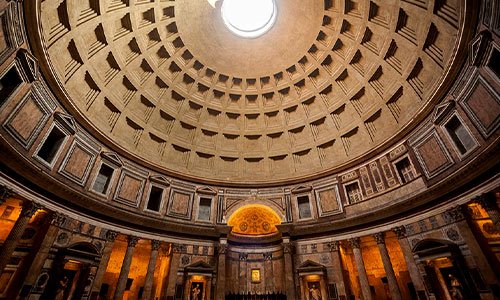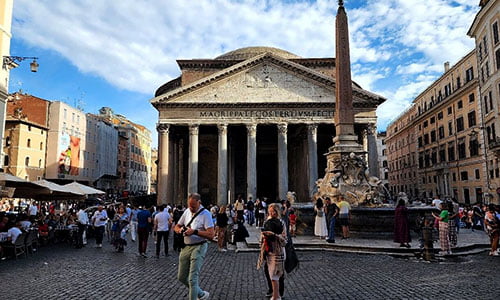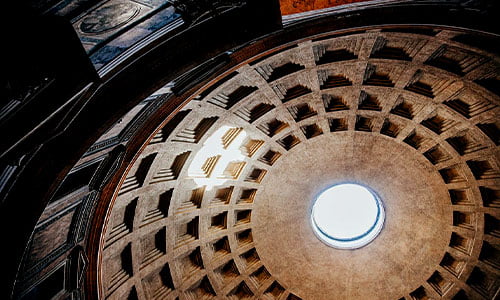The pantheon rome
There are many impressive historical and architectural sites in Rome, but the Pantheon is one of the most impressive. This building dates back to the early second century AD and is one of the best-preserved antiquity buildings in the world. The dome’s central hole, the “oculus,” is the largest in masonry ever constructed.Tourists come to Rome to see the Pantheon, which is a mysterious building that attracts thousands of visitors each year.
Its Latin name Pantheum, both meaning “the temple of all the gods” (as Pantheion means “the temple of all the gods”) derives from its ancient Greek name Pantheion, which means “the temple of all the gods.” People from all over the world travel to Rome to admire its nearly-perfect state of preservation, its regular mathematical proportions, and its huge masonry dome (the biggest built).
AN OVERVIEW OF The Pantheon history


There are two Greek words that translate to “pantheon“: “pan” which means everything, and “theon” which means divine. Rome’s Pantheon was originally a temple dedicated to all of its pagan gods.
An inscription in Latin appears on the façade: “It was built by Marco Agrippa, son of Lucius, third consul.”
The building was constructed between 27 and 25 BC by Consul Agrippa during the reign of Augustus. It was rebuilt by Hadrian after two fires, becoming what it is today.
All visitors are fascinated by the mysteries and legends surrounding the Pantheon, the most mysterious monument in Rome.
Romolo, the founder of the Eternal City, is associated with one of the most famous legends. As it seems, an eagle transported Romulus’ dead body to heaven among the gods inside the Pantheon.
According to another legend, the devil that escaped from the temple created the famous oculus (the circular opening in the center of the dome).

The Pantheon’s shape embodies characteristics originating from different cultures and worlds, merged in a way that is unexpectedly harmonious and elegant. There are elements of the Pantheon that recall the taste of ancient Greece, imperial Rome, and the first Christian basilicas. Especially if photographed from above, its silhouette stands out on Rome’s skyline. With the hemispherical dome roof that overlooks the parthenon, the front view of the temple resembles a Greek temple facade. There is a large apse-shaped body behind the facade, where round geometric shapes contrast with the classic linearity.
It is equally fascinating to look at the interior of the building. All these things contribute to making this building a wonder that leaves visitors enchanted, captivated, and full of amazement. The trompe l’oeil dome, the seven magnificent niches between the Corinthian columns, the richly decorated floor inlaid with polychrome marble, the enormous size of the building, the enormous space inside… all of these things contribute to making this building a wonder.
The dome
There is no doubt that the dome of the Pantheon is the most remarkable part of this structure. In terms of internal diameter, it is the largest dome ever built out of masonry or unreinforced concrete, almost half the length of a football field. Therefore, the building is still intact today, demonstrating the genius of Roman architects. The building was constructed from concrete mixed with volcanic tuff and pumice.The hemispherical dome is enclosed externally by a thick upper wall that encloses the dome’s thrust outwards. The dome appears relatively flat from the outside, but from the top seven concentric rings appear as steps ascending around the side.
Why is there an oculus in the Pantheon?
The huge columns surrounding the high bronze door might overwhelm you as you walk toward it. As the only source of light inside the Pantheon, the stunning circular opening known as the Oculus (eye in Latin) is considered one of the greatest architectural feats of all time. It wasn’t the only purpose of the Oculus. Also, it was built so that people could gaze at the heavens while inside the temple. It was also probably a solar clock.
Is the Pantheon a church?
During the 609 AD era, the Pantheon was given to Pope Boniface IV, who converted it into a church, and it is still in use as a church today. This church is known as the Basilica of St. Mary and the Martyrs, and mass is held there every Saturday at 5 p.m., as well as every Sunday at 10.30 a.m.
What do the letters on the Pantheon mean?
While Hadrian transformed the entire structure, he installed an inscription in bronze letters honoring Agrippa’s first ideator, the Pantheon. An inscription attributed to the foundership to Agrippa was added as a polite gesture. In Latin, the letters on the Pantheon read: “M*AGRIPPA*L*F*COS*TERTIVM*FECIT,” which means: “Marcus Agrippa, son of Lucius, three times consul, built this.”
What time does the Pantheon open?
From the outside of the Pantheon, you can enjoy its beauty at any time of day. It can be marveled at from any of the restaurants on Piazza Della Rotonda, or from the steps of the Fontana del Pantheon in the center of the square. It is also possible to visit the inside of the majestic structure from 9:00 to 19:30, Monday through Saturday, and from 9:00 to 18:00, Sunday. If you are planning to visit during a bank holiday, be sure to check the opening hours.
Opening hours
According to the following table, the Pantheon’s basilica is open during the following hours:
| Date | Opening | |
| Monday | 9:00 | 19:30 |
| Tuesday | 9:00 | 19:30 |
| Wednesday | 9:00 | 19:30 |
| Thursday | 9:00 | 19:30 |
| Friday | 9:00 | 19:30 |
| Saturday | 9:00 | 19:30 |
| Sunday | 9:00 | 18:00 |
For more information, please visit the Pantheon’s official website
It is important to note that the basilica closes at 13:00 on holidays.
It is important to note that the last entry is at 7.15 p.m.
There are three days when the Pantheon is closed: January 1st, May 1st, and December 25th.
Entry may be restricted during religious services.
All visitors to the Pantheon are free of charge
QUESTIONS AND ANSWERS
How to get to the there ?
There is a metro station close to the Pantheon called Spanish Steps. You will find Via del Caravita on your right, just after Via dei Condotti ( in front of the Barcaccia ). Continue along Via del Corso until you reach Via del Caravita. It is exactly in front of the Pantheon that you will emerge.
Do you need a reservation to enter ?
During the week, you can visit the Pantheon for free, but on weekends and public holidays you must reserve your spot ahead of time. In order to reserve a spot, you will need to book an audio guide or a tour.
Is a tour of the Pantheon worth it?
In addition to its fantastic architecture, the Pantheon also contains many interesting stories and facts about its history. You can take a free tour of the Pantheon each evening at 7 pm, which meets just outside the steps. The tour lasts for half an hour and is an excellent way to learn more about this building.
How long do you need in the Pantheon?
If you plan to visit the Pantheon alone, plan on spending 30-60 minutes there. In contrast, if you are traveling with a tour group, you can expect to spend between one and three hours on the trip.
Is there a dress code?
It is important to be aware that many of the churches in Rome have a dress code that needs to be followed. Make sure that you cover your shoulders and knees as well as not wearing flip-flops during the event.
How far is Pantheon from Colosseum?
There is a distance of 2 km between the Pantheon and the Colosseum.
USEFUL INFORMATION
Opening days and times 2024
Basilica is open daily from 9.00 am to 7.30 pm (last entry is at 7.15 pm).
Pantheon admission ends 30 minutes before closing Depending on special religious celebrations, times may vary.
Ticket prices
Admission is free for all visitors.
Closed – January 1st, May 1st and December 25th.
How to get there
Address: Piazza della Rotonda, near Piazza Navona.
